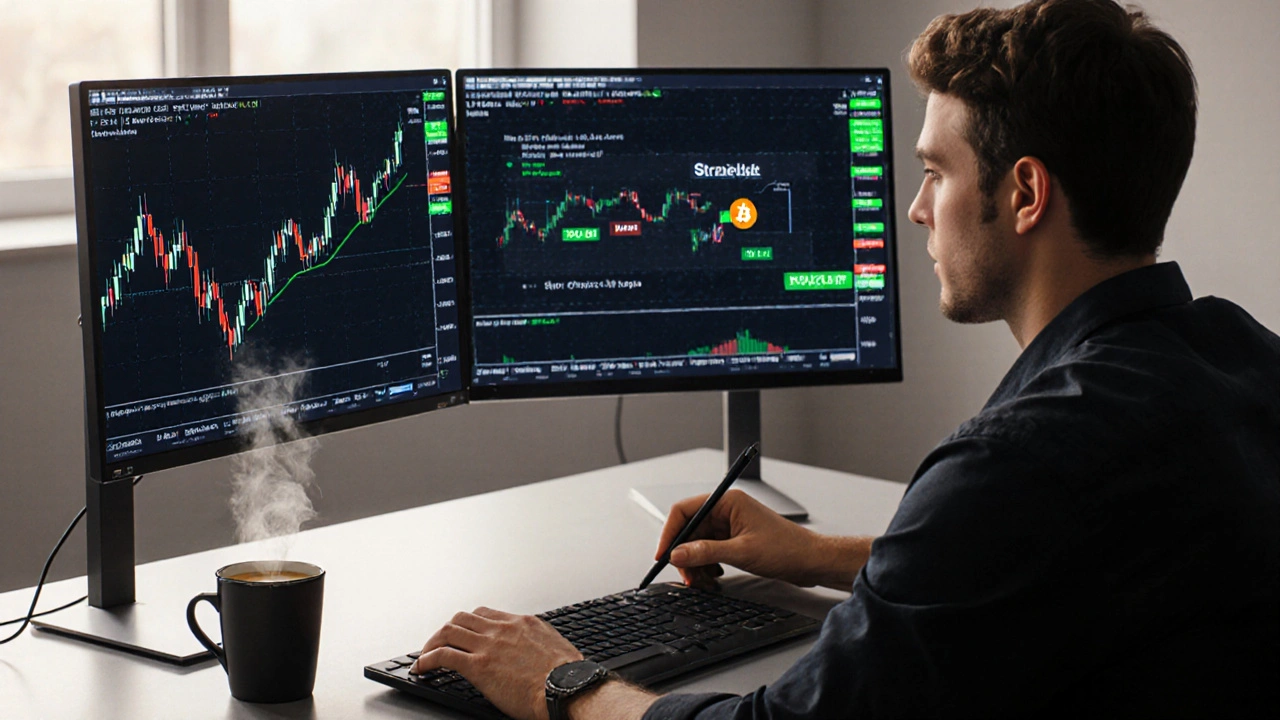Ever wondered how you can bet on the future price of Bitcoin or Ethereum without actually buying the coin? That’s where Crypto Options are contracts that give you the right, but not the obligation, to buy or sell a cryptocurrency at a set price before a specific date. In plain terms, they work like a reservation for a future trade - you lock in a price today and decide later if you want to go through with it. This guide walks you through the mechanics, the key terms, and the typical strategies that traders use to profit (or protect) in the volatile crypto market.
What Exactly Is an Options Contract?
At its core, an Options Contract is a legal agreement between two parties: the buyer (who pays a premium) and the seller (who collects that premium). The buyer gets the right to buy or sell the underlying asset - in this case, a cryptocurrency - at a pre‑agreed strike price before the expiration date. Two flavors exist: a call (right to buy) and a put (right to sell).
Key Building Blocks of Crypto Options
- Underlying Asset: The crypto you’re betting on - e.g., BTC, ETH, SOL.
- Strike Price: The price at which you can buy (call) or sell (put) the asset.
- Expiration Date: The deadline when the option becomes void if not exercised.
- Premium: The up‑front cost you pay to own the option.
- Volatility: A measure of how wildly the price swings; higher volatility usually means higher premiums.
- Liquidity: How easily you can enter or exit the option market; influenced by exchange depth.
How an Option Moves From Purchase to Settlement
- Choose the market: Pick a Derivatives Exchange that lists crypto options - popular choices include Binance, Deribit, and OKEx.
- Select the contract: Decide on the underlying asset, strike price, expiration, and whether you want a call or put.
- Pay the premium: Your account is debited for the option cost plus any transaction fees.
- Monitor the market: As the underlying price moves, the option’s “delta” (price sensitivity) changes.
- Decide to exercise or close:
- If the option is “in‑the‑money” (price favorable), you can either exercise it (actually buy/sell the crypto) or sell the option on the secondary market to lock in profit.
- If it’s “out‑of‑the‑money,” you’ll usually let it expire worthless and lose only the premium.
Call vs. Put: When to Use Each
| Feature | Call Option | Put Option |
|---|---|---|
| Right to | Buy the underlying crypto | Sell the underlying crypto |
| Profit when | Price rises above strike + premium | Price falls below strike - premium |
| Typical use | Bullish speculation, leverage long exposure | Bearish speculation, hedge long holdings |
| Risk | Limited to premium paid | Limited to premium paid |
| Common strike selection | Near‑term at‑the‑money or slightly out‑of‑the‑money | At‑the‑money or slightly in‑the‑money for protection |

Popular Strategies in Crypto Options
Just like in traditional markets, traders mix and match options to shape risk‑reward profiles. Here are three go‑to setups that work well with the high‑volatility nature of crypto.
- Long Call: Buy a call with a strike near the current price. Upside is unlimited; downside capped at the premium.
- Protective Put: Own BTC in your wallet and buy a put to lock in a floor price. If BTC crashes, the put offsets the loss.
- Straddle: Purchase both a call and a put at the same strike and expiration. You profit if price swings far enough in either direction, a handy play around big news events.
Each strategy hinges on a key assumption about volatility and direction. If you expect a big announcement - like an ETF approval - a straddle can capture the jump, while a protective put is the go‑to when you’re nervous about regulatory crackdowns.
Where to Trade Crypto Options
Not every exchange offers the same assets, contract types, or liquidity. Below is a quick snapshot of the major players as of October 2025.
| Platform | Supported Assets | Typical Premium Range (USD) | Notable Feature |
|---|---|---|---|
| Deribit | BTC, ETH, LINK | $15‑$500 per contract | Deep liquidity, futures‑option combos |
| Binance | BTC, ETH, BNB, SOL, ADA | $5‑$300 per contract | Integrated spot & margin accounts |
| OKEx | BTC, ETH, XRP, DOGE | $8‑$250 per contract | Monthly & weekly expiries |
| Bybit | BTC, ETH, AVAX | $10‑$400 per contract | Zero‑fee maker rebates for options |
Before you deposit, check the platform’s KYC requirements, withdrawal limits, and whether it offers insurance funds for extreme market events.
Risks You Can’t Ignore
Crypto options are powerful, but they’re not a free lunch. Here are the top pitfalls and how to dodge them.
- Premium Decay: Time works against you. As expiration approaches, the option’s extrinsic value drops, even if the underlying price stays flat.
- Liquidity Gaps: Small‑cap coins may have wide bid‑ask spreads, making it costly to close a position.
- Margin Calls: If you write (sell) options, you might need to post collateral if the market moves against you.
- Regulatory Uncertainty: Some jurisdictions treat crypto options like securities, which could affect platform availability.
- Over‑Leverage: Using too many contracts relative to your capital can wipe you out in a single swing.
Start with a small portion of your portfolio (5‑10 % of total crypto holdings) and practice on demo accounts where available.

Step‑by‑Step Example: Buying a Bitcoin Call
Let’s walk through a concrete trade so the abstract concepts click.
- Market snapshot: BTC is trading at $28,000. You expect a price jump due to an upcoming halving event.
- Select contract: Choose a 30‑day call with a $30,000 strike on Deribit.
- Check the premium: The option costs $850 per contract (roughly 3 % of the underlying price).
- Place the order: Pay the premium and receive the option token in your account.
- Monitor price movement: Two weeks later, BTC hits $32,500.
- Calculate payoff: Intrinsic value = $32,500 - $30,000 = $2,500. Subtract premium $850 → net profit $1,650 per contract.
- Exit: Either exercise (buy BTC at $30,000, then sell at market) or sell the option on the secondary market for its new price (likely ~$2,200).
If BTC had stayed below $30,000, you’d lose the $850 premium, which illustrates the limited‑risk nature of buying calls.
Quick Checklist Before You Trade
- Define your market view (direction & time horizon).
- Pick the right underlying crypto and strike price.
- Calculate potential loss (premium) vs. expected gain.
- Verify platform liquidity and fee schedule.
- Set a stop‑loss or pre‑planned exit point.
Frequently Asked Questions
What is the difference between crypto options and futures?
Options give you a right without obligation, while futures bind you to buy or sell at the contract price on the expiry date. This means loss on a futures position can exceed the initial margin, whereas an option buyer can only lose the premium paid.
Can I exercise a crypto option on a decentralized exchange?
Some DeFi platforms like Opyn and Hegic let you mint and settle options on‑chain, but most retail traders use centralized exchanges for simplicity. On‑chain options require you to lock collateral in a smart contract before exercising.
How does volatility affect option pricing?
Higher expected volatility inflates the premium because the chance of the option ending up in‑the‑money rises. Traders often use the Black‑Scholes model or the more crypto‑friendly Bachelier model to estimate this impact.
Is buying a protective put a good way to hedge my Bitcoin holdings?
Yes. A put with a strike near your current holding price sets a floor. If BTC drops sharply, the put’s payoff offsets the loss, letting you stay long without fearing a total wipe‑out.
Do I need to pay taxes on crypto option profits?
In the U.S., options are treated as capital assets. Short‑term gains (held < 1 year) are taxed as ordinary income, while long‑term gains enjoy lower rates. Always consult a tax professional for your specific situation.
Wrapping It Up
Crypto options give you a flexible toolbox to speculate, hedge, or generate income in a market that moves 24/7. By mastering the core elements - strike, premium, expiration, and volatility - you can design strategies that match your risk appetite. Start small, pick a reputable exchange, and keep an eye on the ever‑shifting regulatory landscape. With practice, the right option trade can turn a price swing into a predictable profit.

10 Responses
Hey folks! If you're just dipping your toes into crypto options, start small and treat each contract like a practice round. Focus on the strike price, the premium you pay, and how long you have until expiration – those three basics will save you a lot of teh head‑ache later. Remember, you can always close a position before expiry to lock in profit or cut losses, so you aren't stuck with a losing bet. Also, keep an eye on liquidity; markets with tight spreads make exiting easier. Good luck and happy trading!
The guide provides a concise overview of options terminology. It is advisable to evaluate the premium relative to the underlying asset price. Consider using a reputable exchange before executing trades.
When one contemplates the intricacies of crypto options, one must first acknowledge the sheer complexity inherent in the derivatives market, a realm where price, time, and volatility intertwine in a delicate ballet. The strike price, ostensibly a simple number, actually embodies the fulcrum upon which profit and loss pivot, demanding rigorous analysis of current market sentiment and projected trajectories. Moreover, the premium, often dismissed as a mere cost, functions as a quantifiable reflection of implied volatility, a metric that oscillates dramatically in response to macro‑economic whispers and on‑chain fundamentals alike. One cannot, however, neglect the expiration date, for it imposes a temporal constraint that transforms the option from a static contract into a living instrument, susceptible to the relentless march of time decay. Time decay, colloquially termed theta, inexorably erodes extrinsic value, compelling traders to adopt strategies that either capitalize on rapid price movements or mitigate the inevitable loss of time value. In practice, a long call may flourish when bullish sentiment aligns with a narrowing bid‑ask spread, whereas a protective put serves as an insurance policy against unforeseen market downturns, each strategy bearing its own risk‑reward profile. Liquidity, an oft‑overlooked variable, dictates the ease with which positions can be entered or exited, and in illiquid markets, slippage can transform a modest premium into a prohibitive expense. Consequently, selecting an exchange with deep order books-such as Deribit, Binance, or OKEx-becomes a strategic decision, one that should be informed by both fee structures and regulatory considerations. Regulatory uncertainty adds another layer of nuance, as jurisdictional interpretations of crypto derivatives can alter the very legality of an instrument, a factor that astute traders monitor with vigilance. When constructing a straddle, for instance, the trader purchases both a call and a put at the same strike, thereby betting on volatility rather than direction, a tactic that can yield substantial profit during high‑impact news cycles. Conversely, a calendar spread leverages differential time decay by selling a near‑term option while buying a longer‑dated one, a maneuver that profits from the faster erosion of the short‑term contract. These multifaceted strategies, while theoretically sound, demand disciplined capital allocation; allocating no more than ten percent of one's portfolio to options mitigates the potential for catastrophic loss. Risk management, therefore, extends beyond stop‑loss orders to encompass margin requirements, collateralization, and the psychological fortitude to endure inevitable drawdowns. One should also recognize that the Black‑Scholes model, though foundational, may misprice options in the crypto sphere due to extreme kurtosis and fat‑tailed distributions, prompting the use of alternative models such as Bachelier or Monte Carlo simulations. Finally, continual education-through backtesting, paper trading, and engagement with community discourse-remains indispensable, for the landscape of crypto options evolves at a pace that renders complacency a costly vice. In sum, mastery of strike selection, premium assessment, expiration timing, and volatility estimation equips the trader with a robust toolkit, enabling calculated exposure to a market that rewards informed audacity.
Whether you're bullish or bearish, crypto options give you the flexibility to act without over‑committing capital. Choose a strategy that fits your risk tolerance, and stick to it; consistency beats chasing every price swing. Remember that protecting your downside with puts can be just as powerful as riding a rally with calls. Stay disciplined and you’ll navigate the volatility with confidence.
It’s true that volatility can make pricing models feel like guesswork, but that uncertainty is also where opportunity lives. When you pair a protective put with a solid long‑term holding, you create a safety net that lets you stay invested without fear of sudden drops. I also appreciate the reminder about capital allocation; keeping options to a modest slice of the portfolio preserves flexibility. In my experience, a well‑timed straddle around major announcements can capture outsized moves that a simple directional bet would miss. Moreover, monitoring the Greeks-especially delta and vega-provides insight into how price changes and volatility shifts will affect your position. Ultimately, disciplined risk management and continuous learning are the twin pillars of sustainable success.
Don’t be fooled by the glossy marketing of Deribit or Binance; behind those platforms lies a web of hidden exchanage fees and regulatory loopholes, all designed to siphon off the little guy’s profits, they claim deep liquidity, yet during a flash‑crash the order books freeze, leaving traders stranded, some insiders even whisper that the pricing algorithms are subtly rigged to benefit the house, especially on volatile coins like DOGE, keep your eyes peeled, because the more you trust the big names, the deeper you fall into the trap they set, remember, decentralization is the true answer-look into on‑chain solutions like Opyn, even if they’re less polished.
Your claim that every exchange is a secret trap is, frankly, a textbook example of hyperbole lacking any concrete evidence. While it’s prudent to stay vigilant, dismissing all centralized platforms ignores the fact that many users successfully trade options without incident. Moreover, the grammar in your post could use a refresher; “exchanage” and “whisper” are misspelled, which undermines your credibility. If you want to persuade rational readers, present data, not unfounded paranoia. Otherwise, it’s just noise.
Great points all around-especially the emphasis on starting small and using demo accounts before going live; that’s a smart way to build confidence. Remember to set clear entry and exit criteria for each trade; having a plan reduces emotional decision‑making. If you hit a losing streak, take a step back, review your journal, and adjust your strategy rather than chasing losses. Keep learning, stay disciplined, and the market will reward your consistency. You’ve got this!
Sure, because crypto options are totally risk‑free.
Actually a little risk can be fun and help you learn.